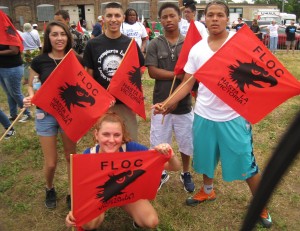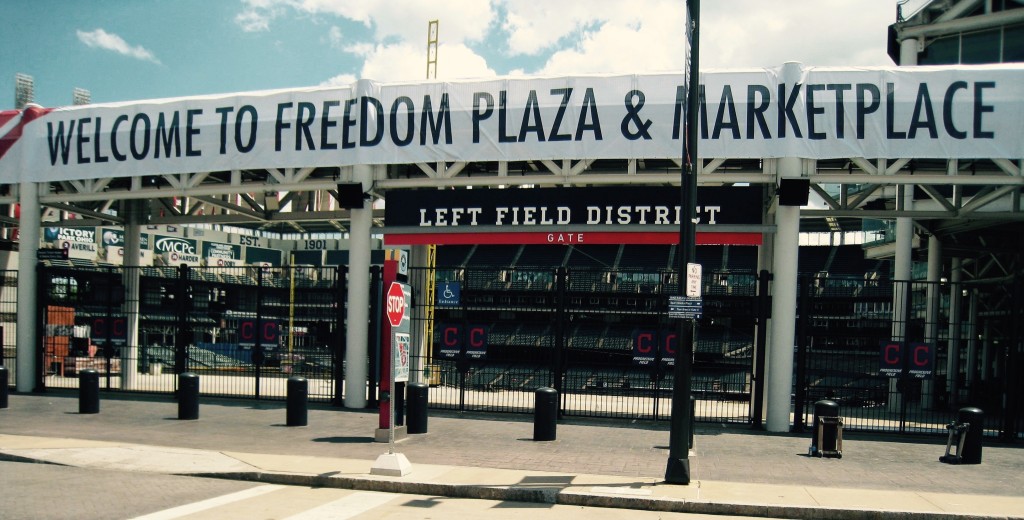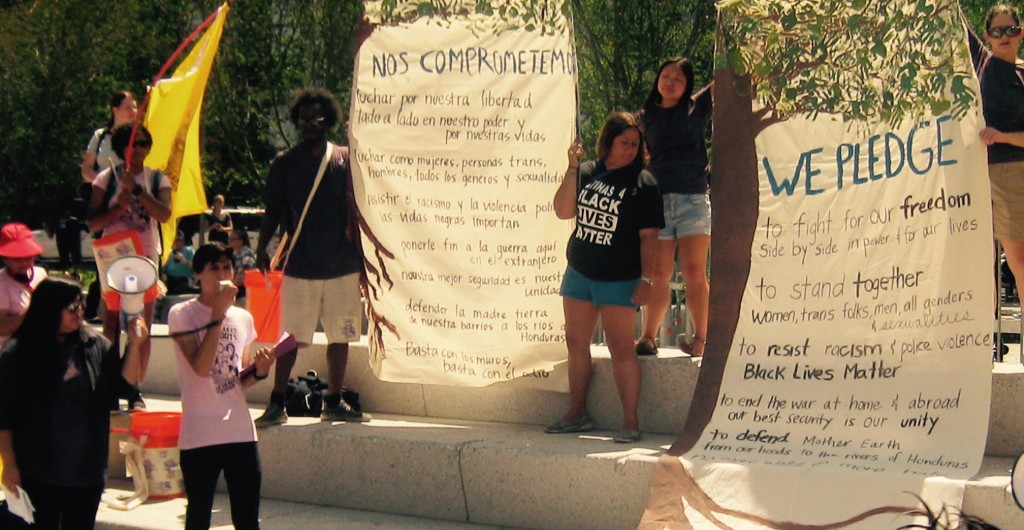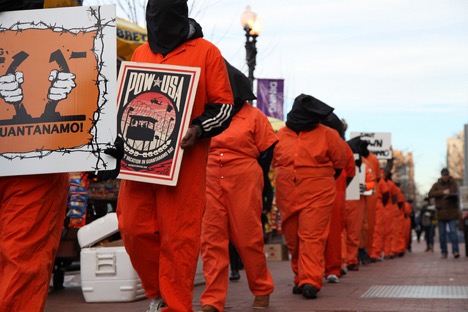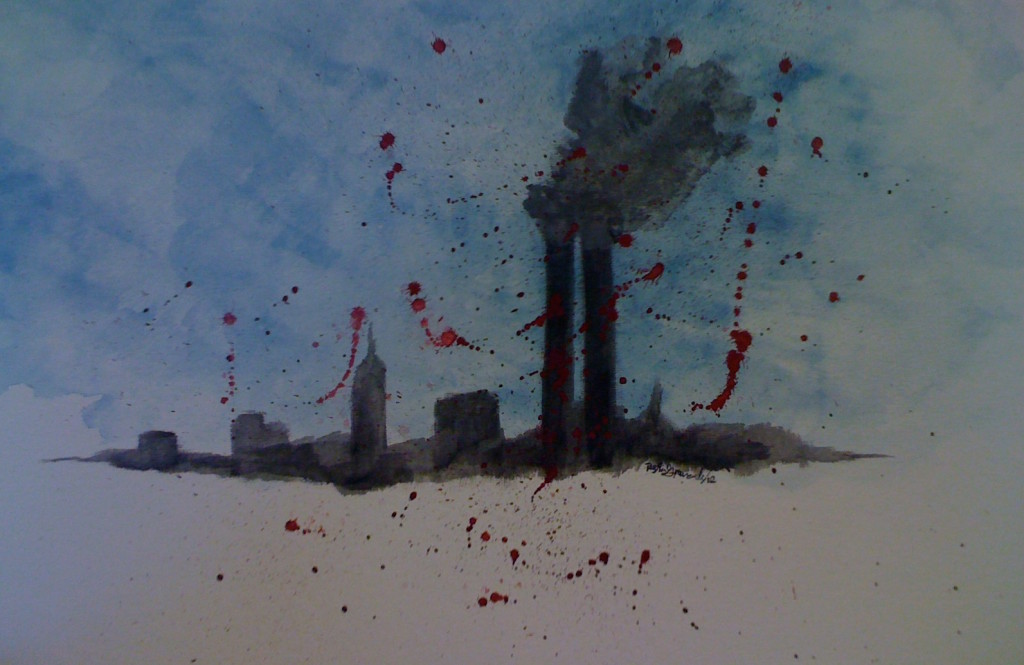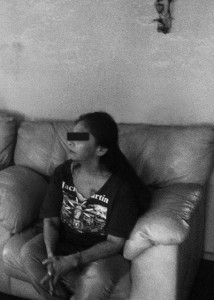by Bob Barber*
In this series of dispatches, veteran Bay Area journalist Bob Barber shares his impressions and views from the streets of Cleveland, Ohio, during the Republican National Convention.
• Friday, July 14
It’s hot here in Cleveland, like in the 80s with the predictable humidity. Just like those good old summer days I remember while growing up here. But next week it’s supposed to get hotter. In the weather and on the streets.
Downtown Cleveland, Public Square, a mile away or so from the Quicken Loans Arena/Progressive Field. Not much is “happening” directly. But the streets are slowly being closed down for the duration of the convention. Eight-foot-high continuous metal fencing is being put up around the big office buildings. The police helicopter buzzes overhead.
Public Square, which is apparently where the “free speech” space is going to be, looks today like a typical weekday lunchtime. But the pro-life forces are out, with big signs and a couple of large trucks driving around and around the square, with huge grotesque photos on their sides and “Defund Planned Parenthood” in block letters. One of the folks told me they had been there all week because the goal was to influence the Republican platform and make sure it had the “defund Planned Parenthood” plank, in which they succeeded. They weren’t being pro-Trump or anti-Trump, they just wanted the platform language. An hour later they were gone.
Overhead, a small plane circles lazily trailing the banner “TrumpReleaseYourTaxReturns.com”.
Over by the “Q” arena and the baseball stadium, all the outer walls are blanketed with RNC banners and such. No more giant photos of LeBron James for now. The great Left Field Deck of the stadium is renamed “The RNC Freedom Marketplace.”
Around town you can pick up the current issue of the local alt-weekly Scene, which contains “A Very Special R.N.C. Coloring Book: Because If They Can Act Like Children, So Can We!” Featured on the cover, ready for your crayons, is Donald Trump as King Kong, climbing the Terminal Tower and swatting away the biplanes.
The police force has apparently received a $50 million federal grant and beefed up its force from 1,500 up to about 4,000. It seems to be the only US police force undertaking such a mission while under direct federal monitoring for corruption, excessive use of force, etc.
I ask one of the staff people sweeping the public square whether they are worried. She says, well yes, “but having a trial run with 1.3 million people a couple of weeks ago was good practice (i.e., at the Cavaliers’ celebration).” “On the other hand,” she adds, “they were all happy.”
There probably won’t be that many people here next week, but they most certainly won’t all be happy.
(And, oh yes, all over the freeways, those electronic billboards are reminding everyone: “If You See Something Say Something. Call the RNC Tip Line 1-800-Call-FBI.” I kid you not.)
• Saturday, July 15
The People’s Justice and Peace Convention, which will be going on here side-by-side with the RNC, has been in the works in Cleveland since late 2015, before Trump was the “presumptive nominee” or anything. It took me a while to get a handle on the activities, and the sponsors, and the general idea. It appears that the idea was motivated first by activists in the Cleveland Nonviolence Network, the Sierra Club, and others. I couldn’t help but look for the invisible, conspiratorial groups behind the scenes. Didn’t find them. But that doesn’t really prove anything.
This convention was described as the capstone activity, as a multi-page, multi-issues draft platform was presented for finalization and presentation to both the Republican and Democratic parties. I didn’t stay for the whole thing. But it was pretty clear that their work would have been much the same no matter who the nominees were to be. The platform includes sections on economic justice, international justice, and racial and social justice. I wondered if this was part of a national series of related efforts. Apparently not.
The event was held mostly at Olivet Institutional Baptist Church, one of the many large black churches in Cleveland that have been at the heart of activism and popular struggle for decades. Some church members were deeply involved, but I would say that most participants were younger and older white activists. A few national organizations had their hand in, such as Codepink.
It felt a lot like conferences and activities that I’ve been to before. Maybe a little more “civil” in the disagreement sphere—or maybe the disagreements had all been fought out before today. For example, the workshop on the Boycott/Sanctions/Disinvestment movement appeared to have no one who opposed the idea, which may suggest either that this type of action has moved toward the “mainstream” of progressive thinking, or that opponents had dropped away.
An animated and tense discussion emerged during the workshop on Combating Islamophobia. Some wanted to connect historical white hatred of Muslims with white racism against blacks (so many black slaves were Muslims), and others expressed disappointment that their efforts to be “American” were being increasingly rebuffed. One woman said she felt that even to go outside into the world on any given day and remain proud was her personal form of jihad—which she said means mainly ‘to persevere in the face of hardship.”
And there was quite an argument in the workshop on education as to how to hold teachers “accountable,” even if not by the use of standardized tests.
I asked several of the black members of the Olivet Baptist Church whether they expect “trouble” next week in Cleveland. One woman said, “No—not from us—we’re not going to destroy our own city. But maybe from outsiders.” The memory of the Hough and Glenville “riots” in Cleveland in the 1960s is still very real here. Another woman told me that she had been a teenager in Birmingham when George Wallace was governor of Alabama. “He was beyond all boundaries of rationality. I had thought we were past all that. But maybe the hatred has come back. Or maybe it just went underground and never really went away. Look at Trump.”
Elsewhere in Cleveland today, it was reported on local TV that organizers of a rally involving some Black Lives Matter people and the New Black Panther Party had decided not to pursue their “open carry” rights as had once been considered. I don’t have any independent verification of that. Open carrying of some guns is legal in Ohio, and we probably haven’t seen the last of that aspect.
Over the next couple of days, the scene is most likely going to intensify. I’m aware of several progressively oriented marches Sunday and Monday. But also, the Westboro Baptist Church people are arriving from Kansas, along with Bikers for Trump and I’m not even sure who else. (Here is an interview in which the Bikers for Trump leader explains that they are coming to Cleveland to “help keep things calm.”)
• Sunday, July 16
Downtown today there didn’t seem to be much happening. Clumps of bystanders and tourists. RNC delegates looking around trying to get their bearings and find things to do. Media and people and photographers looking for things to cover. The security perimeter is expanding slowly but surely, constricting access for vehicles and pedestrians. The shooting of police officers in Baton Rouge has put everyone even further on edge, even as the specifics and details remain somewhat obscure as I write this.
The airplane-towed banner of the day overhead: “Hillary for Prison 2016: Infowars.com.” In Public Square a lone individual with a rifle strapped over his shoulder (open-carry, legal) is surrounded by a horde of reporters. The only part of the dialog I could hear was a question as to whether he was worried whether there might be an accidental discharge. “Guns don’t go off by accident,” he said.
But in the afternoon, a planned event called “Circle the City with Love” brought a couple of thousand people out to march from the city’s west side over a bridge on the Cuyahoga River to the east side with a message of peaceful coexistence among communities and authorities. (See here for more.) Another march through downtown was more politically focused on an anti-Trump and antiracism message.
Tomorrow begins the “real thing.” The Republican Party announced that the theme of the day will be “Make America Safe Again.” Speakers are said to include Rick Perry, Rudy Giuliani, and Melania Trump, among others.
• Monday, July 18
Fifty years ago today in 1966 the “Hough riots” broke out in Cleveland after an incident involving the refusal of a restaurant owner to provide a glass of water to a black customer, instead posting a racist sign, “no water for niggers [sic].” This spark lit an urban fire that was ready to happen. Enormous destruction and loss of life ensued. These events and later ones in Cleveland also had an enormous effect on me as a high school student at the time in a nearby suburb. There are numerous histories of this watershed event in Cleveland and the country (here’s one). This anniversary is not far from the minds of many black Clevelanders, I’ve discovered this week.
Three years ago today, the young black man Tyrone West was the victim of police violence in Baltimore, not long after George Zimmerman was acquitted in the killing of Travon Martin in Florida. (The story is told here.)
On this July 18 in Cleveland, the “public spaces” opened up. One “public space,” a speakers’ platform in the downtown Public Square, has been reserved by almost 50 individuals and organizations over the next days. Today I was there to hear speakers from Black on Black Crime, Inc., a Cleveland non-profit, focus on the fact that multiple shootings and killings took place over the weekend in black communities while hundreds or thousands of police were downtown guarding the convention (see here). The speakers urged the national and international media as well as Republican delegates to go visit the “real Cleveland.” They also urged black youth to “throw down your weapons and seek guidance from your elders.” And they thanked Donald Trump for “bringing white supremacy out of the closet.” The demand for better police protection in black communities is being raised throughout the country.
Two public parks that are more than a mile or two from the convention area opened today also as public political spaces, but, as of this morning, very few of the organizations with reserved space seemed to have arrived. It’s hard to imagine too many people will go to these spaces unless they have a specific desire to do so. It would be tempting to say this was the idea.
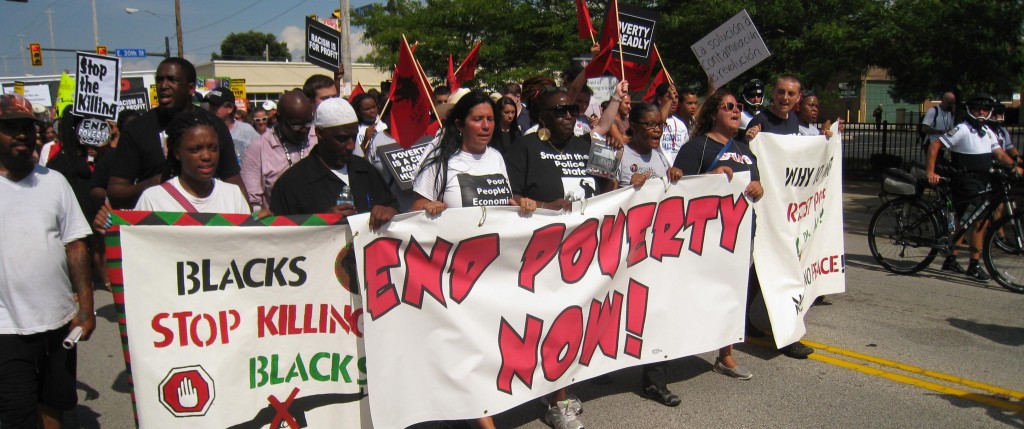 The March to End Poverty (http://endpovertynow2016.org) drew maybe 1,000 people for a rally and march through the east side of Cleveland into downtown. This was another event where the politics were independent of the candidates. Participants included local, regional, and national organizations and ranged from The Lorain Ohio Immigrant Rights Association (LOIRA) to the Farm Labor Organizing Committee (FLOC), which has been organizing tomato pickers and others in Ohio and elsewhere for decades (see pictures), to a range of socialist and communist organizations, to black community activists and a variety of musicians.
The March to End Poverty (http://endpovertynow2016.org) drew maybe 1,000 people for a rally and march through the east side of Cleveland into downtown. This was another event where the politics were independent of the candidates. Participants included local, regional, and national organizations and ranged from The Lorain Ohio Immigrant Rights Association (LOIRA) to the Farm Labor Organizing Committee (FLOC), which has been organizing tomato pickers and others in Ohio and elsewhere for decades (see pictures), to a range of socialist and communist organizations, to black community activists and a variety of musicians.
The crowd included a large number of older movement veterans and a larger number of younger activists of all kinds. No wonder the music alternated between the live performance of the hip-hop supergroup Prophets of Rage and recorded versions of Neil Young’s Four Dead in O-hi-o and Buffalo Springfield’s For What It’s Worth. Something happen’n here, indeed. (Speaking of music, I also learned that Woody Guthrie wrote a song in 1950 about the Donald’s racist slumlord father Fred, called Old Man Trump. See here and here. Woody may never have recorded it but Ani DiFranco and Tom Morello did—the link in the first of the two mentioned here.) Chatting with several in the crowd about youth and age, I got feedback that followed a common theme, summarized by one like this: “The elders know things the youth need to learn, and the youth see things the elders don’t.”
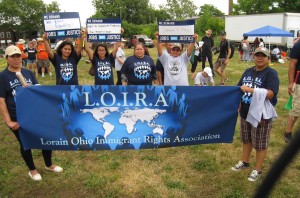 Another theme emerged in conversation about the meaning of the Hough riots 50 years later. More than a few people told me it seems that the current moment is cycling us back to even before those days, in terms of the overt racism and xenophobia afoot in the country. But at the same time they recognize that positive change has occurred in US society. “Too many youth don’t really know what it took to get us this far” was a common observation.
Another theme emerged in conversation about the meaning of the Hough riots 50 years later. More than a few people told me it seems that the current moment is cycling us back to even before those days, in terms of the overt racism and xenophobia afoot in the country. But at the same time they recognize that positive change has occurred in US society. “Too many youth don’t really know what it took to get us this far” was a common observation.
Then there were the police. Thus far, in the last few days, it appears no overt conflicts have broken out between police and demonstrators. That could change of course, although hopefully not. The police presence is overwhelming—in preparing for this week local and state police have come in at least from, according to what I’ve seen, Florida, Michigan, New Orleans, and Austin. What’s new (or maybe not so new) is the degree to which they use bicycles to move about, to exercise crowd control, to re-deploy, and so on. If you’ve viewed some of the TV or Internet coverage, there’s a good chance you’ve observed this.
In the evening, I’ve been distracted while RFLMAO over Stephen Colbert’s take on the first night of the convention. I hope you have too. A little laughter in the midst of all this scariness can’t be bad.
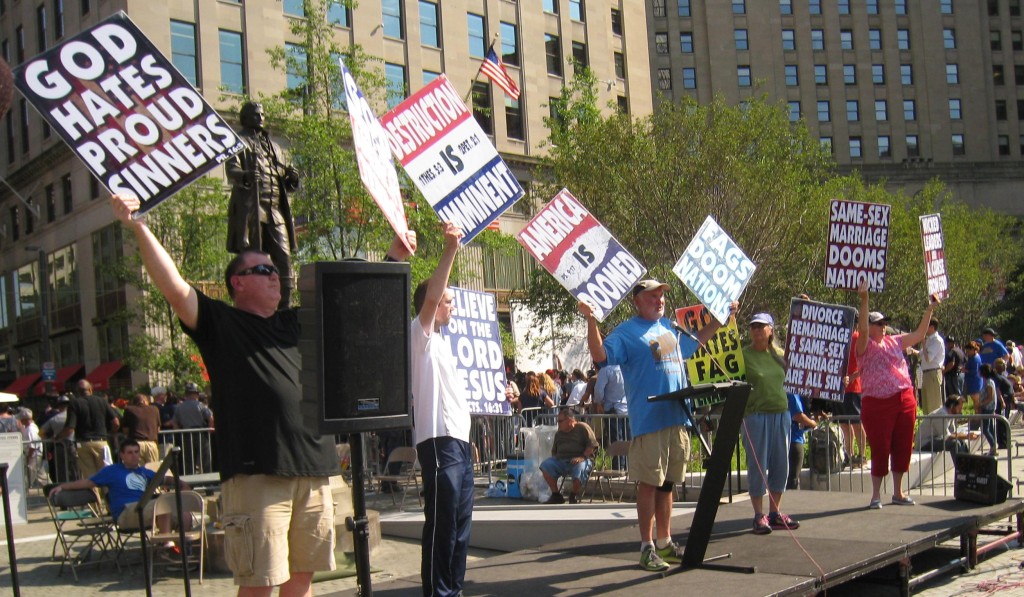
• Tuesday, July 19
They say the next few days will apparently see even warmer temperatures and higher humidity in Cleveland. But wait, there’s more, maybe. If you caught any of the TV or other news coverage on Tuesday of what went on outside the convention, you might be worried too, since there’s two more days to go.
In the mid to late afternoon Tuesday the downtown Public Square filled with people. Some fights started. A lot of yelling was going on. As I got there from another rather startling experience elsewhere (more on that below), squads of police were rushing into the space with their bicycles and on foot, quickly pushing through the crowd and dividing the space into four quadrants so it became more difficult for people to get into each others’ faces. News reports indicate a few arrests were made and after a few hours the scene quieted (a local news report on the day can be found here). But I detected something disquieting.
At the peak of the chaotic moments, from one corner came a chant: “Off the Pigs.” From another corner, someone with a bullhorn carrying a Trump sticker was shouting “Blue Lives Matter” (as you may know, a counter to “Black Lives Matter” that refers to police). At the public microphone at the Square, members of the Kansas-based Westboro Baptist Church were proclaiming their certainty that “God Hates Fags.” And most amazingly, perhaps, on another side of the square to their right, a group of opposing Christian conservatives were accusing the Westboro people of hating the military and the police and assuring them that when they went to hell, they should not plan to call the army or 911 for a rescue.
Little of this had much directly to do with Donald Trump or Hillary Clinton, although they both got called some pretty nasty names, as did Barack Obama. Tempers as well as temperatures seem to be rising.
I can expand a bit here on the conflict between the Westboro people and their opposition because I witnessed two separate incidents within an hour or so of each other. I have to say these were among the most bizarre spectacles I have ever witnessed.
You may have heard of the Westboro Baptist Church: in addition to their virulently anti-gay ideology and activities, they often picket public military and police funerals because they believe these memorials represent the worship of idol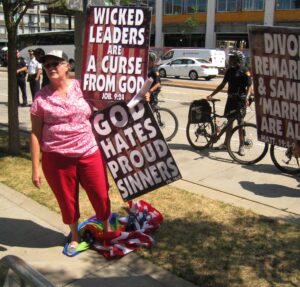 s instead of the one true God (this is how one of those church members described it to me). They had a scheduled event today at the edge of the Cleveland State University (CSU) campus, holding their signs for motorists and passers-by while one of the members stomped on a US flag and a rainbow flag at the same time (see picture). Another member told me, when I asked, that they see the presidential race as featuring “a baby-killer and proponent of sodomy on the one side and a serial adulterer on the other side,” both indicative of the “wicked leadership” under which the US suffers. No endorsement for either, there. Why had they come to Cleveland? I asked. Because they go where large numbers of people who live under idolatry are gathered, to spread their message.
s instead of the one true God (this is how one of those church members described it to me). They had a scheduled event today at the edge of the Cleveland State University (CSU) campus, holding their signs for motorists and passers-by while one of the members stomped on a US flag and a rainbow flag at the same time (see picture). Another member told me, when I asked, that they see the presidential race as featuring “a baby-killer and proponent of sodomy on the one side and a serial adulterer on the other side,” both indicative of the “wicked leadership” under which the US suffers. No endorsement for either, there. Why had they come to Cleveland? I asked. Because they go where large numbers of people who live under idolatry are gathered, to spread their message.
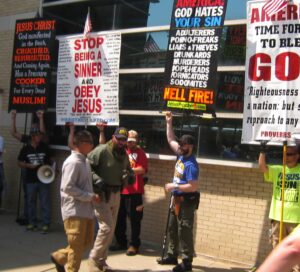 But waiting for them when they arrived at CSU was another group of people with their own signs and bullhorns. I never did discover if this is a group with a name but their signs referred to the websites http://jesuspreacher.com and http://warnthewicked.com. This group insulted the Westboro group in more ways than you could count or would want to repeat, for about half an hour. Then they left. “Shame on you for defiling our soldiers” was one of the more polite comments. I have some audio recordings of both groups and I can’t even bring myself to listen to them, let alone spread them around.
But waiting for them when they arrived at CSU was another group of people with their own signs and bullhorns. I never did discover if this is a group with a name but their signs referred to the websites http://jesuspreacher.com and http://warnthewicked.com. This group insulted the Westboro group in more ways than you could count or would want to repeat, for about half an hour. Then they left. “Shame on you for defiling our soldiers” was one of the more polite comments. I have some audio recordings of both groups and I can’t even bring myself to listen to them, let alone spread them around.
About an hour later this scenario was recreated downtown at Public Square, as I mentioned. But there this face-off became part of the larger chaos I described above. You could imagine that the only missing element was someone with a gun in the square or on a roof nearby (although who knows if they were missing). This is where I begin to worry that the until-today relatively controlled street scene may be on the verge of falling apart. A couple of spontaneous marches broke out of the square late today. Meanwhile, as you probably know, the attacks on Hillary Clinton from Chris Christie and others inside the convention grew to what one friend wrote me sounded like a virtual call for lynching (I didn’t hear Christie). As far as I can tell, the major scheduled anti-Trump marches have already taken place, potentially leaving protesters with little to do besides get angry at pro-Trump forces or the police, and vice versa. The public speaking platform at Public Square will remain open, making it entirely possible that the scene at the Square or elsewhere could get really ugly.
I certainly hope not.
• Wednesday, July 20
Wednesday here in Cleveland at the Trump Republican Convention. The street protest scene is winding down, not heating up, I think. My concern that the end of organized action might lead to greater chaotic action did not materialize. For most of the day, police and media representatives greatly outnumbered everyone else in Public Square. Otherwise, at various times, the apparently most disciplined groups dominated the scene.
The men from the conservative Christian WarnTheWicked.com, about whom I wrote yesterday, kept their megaphone going for hours, with intermittent heckling from LGBT folks and supporters. At one point, as well, NARAL (National Abortion Rights Action League) had the public microphone across the square and they had some back-and-forth.
The Revolutionary Communist Party (RCP) contingent had their megaphone time at the Square as well, after their attempt to burn a US flag at the delegate entry point to the convention a mile or so away resulted in a number of arrests and dominated local news coverage.
No real conflict took place in the Square. My guess is that contrary to my concerns, the end of organized activities led to a reduction in direct protest, not an increase. Other factors were probably at play as well—fatigue, heat, work schedules.
But, as I learned too late to get there, community organizing continued to be the focus of a gathering at the Olivet Institutional Baptist Church on Cleveland’s east side, where I began this series of reports several days ago at the People’s Justice and Peace Convention.
I had a chance to chat with a couple of young white guys in the Square, Trump supporters, and ask them about their outlook on the current moment. Their pictures are attached.
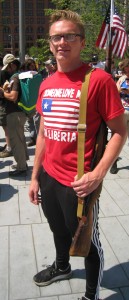 Jason said he comes from a “fairly nuclear middle class family,” is a political science major in college in Cleveland, and works at a local tavern as a bar-backer and busser. He hopes to go into a career at the State Department or Peace Corps, drawing on his experience of community service at his church, “to share America with the world.” He said “we may not perfect in every respect but we are the best in the world.” Jason was carrying a rifle (1942 vintage single-bolt action)—one of the few “open carriers” at the square this week. He said he is exercising his Second Amendment right backed by state law and wants to “destigmatize gun ownership against the dangerous media tendency to make all gun owners out as crazy people.” He supports Trump because Trump wants “to make America first, as it should be,” as compared to the “internationali
Jason said he comes from a “fairly nuclear middle class family,” is a political science major in college in Cleveland, and works at a local tavern as a bar-backer and busser. He hopes to go into a career at the State Department or Peace Corps, drawing on his experience of community service at his church, “to share America with the world.” He said “we may not perfect in every respect but we are the best in the world.” Jason was carrying a rifle (1942 vintage single-bolt action)—one of the few “open carriers” at the square this week. He said he is exercising his Second Amendment right backed by state law and wants to “destigmatize gun ownership against the dangerous media tendency to make all gun owners out as crazy people.” He supports Trump because Trump wants “to make America first, as it should be,” as compared to the “internationali sts” who destroyed the steel industry in Cleveland.
sts” who destroyed the steel industry in Cleveland.
The other young man, whose name I unfortunately failed to get, stood out in his Breitbart.com-marketed t-shirt reading “Border Wall Construction Co.” He told me the election to him is about whether there is a global government or a United States of America. Would he work on a wall on the border? I asked. “Sure—the pay would probably be pretty good,” he said. I wondered what it would take to help these guys and many other people come to a different understanding.
• Thursday, July 21
The scene at downtown’s Public Square was chaotic and noisy all day, with many of the same organizations hectoring each other, far outnumbered by police and media. One new and refreshing group that took the public microphone was the Grassroots Global Justice Alliance, a heavily youth-based network of organizations from around the country that has been growing since about 2005 (see picture). I loved how organized and articulate they were. And having arrived by caravan to Cleveland, they’re on their way to Philadelphia with the same messages for the Democrats, as are probably any number of other groups.
A march was scheduled to cross one of the Cuyahoga River bridges, organized by health workers at the (huge) Cleveland Clinic, under the name Stand Together Against Trump (STAT). They wore t-shirts reading “Muslim Doctors Save Lives in Cleveland.” Some confusion ensued and apparently they ended up returning back across the bridge, maybe forced by police or maybe of their own decision. The local online report is here.
Before all that, I went back to the Olivet Institutional Baptist Church on the east side, where a conference called Impact 2016 has been going on all week to follow up on last week’s People’s Justice and Peace Convention. Today the group was discussing the problem of how to ensure their young people know their own history. My impression was that for them, moving along on community business like this was more important than protesting in the streets. I was glad to start and end my week there.
• • •
Some initial concluding thoughts: As we move forward, one issue that is right on front of us is the management of protest and discontent. I’m pretty sure there will be quite some detailed discussion of this in journals and blogs in the coming weeks, both at this Republican convention and Democratic one. The design of the public spaces around the convention area was pretty clearly aimed at fragmenting and disorganizing dissent—not that progressive forces don’t also contribute a level of fragmentation. But beyond the design of space, the level of police presence was overwhelming. As widely reported, police were brought in from all over the country, and they had what was probably a great opportunity to practice coordination among themselves, the use of tactics involving bicycle and motorcycle brigades and up-to-date lightweight body armor, and crowd control. This needs a lot of analysis by those who are in a position to do so. Actually, the loudest and most frequent sirens you would hear through the city was when several busloads of police were being moved around in convoys of buses accompanied by motorcycles with lights flashing and sirens screaming. At any given point or moment, it was a common sight to see police units deploying and redeploying on foot and on wheels. Are we seeing a “new normal”?
More striking, and certainly more positive, was the complexity of the “generation gap.” So many organizations and activities involved large numbers of young people of all colors, genders, sexual orientations. A high level of awareness clearly exists among them that it is their future that is directly at stake in the current crises of race, class, and especially environmental destruction. At the same time, from the Black church to the Public Square, “elders” are struggling with how to effectively pass on what we know while reflecting on what we don’t know, about how the world looks to the next generations. The single most profound comment I think I heard this whole week, as I mentioned a few days ago, is that “elders know things that youth don’t, but youth see things the elders don’t.” How do we turn that insight into action?
Then there is Cleveland. Behind the glitter of the convention is a city and a population that is in desperate straights. Even the local TV stations had to acknowledge it is a “tale of two cities.” When speakers urged the national and international media to “come see the real Cleveland,” they meant it. Interestingly, the New York Times published a video report today which captures the reality of life in large swaths of the black community (here). This says it better than I ever could.
• • •
* Bob Barber is a veteran Bay Area journalist and activist in movements relating to anti-imperialism, racial and social justice, and labor organizing.



